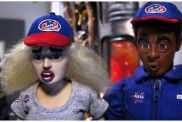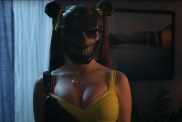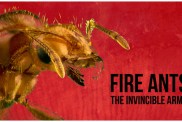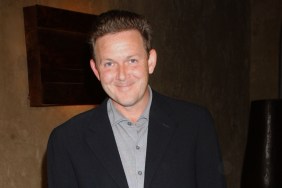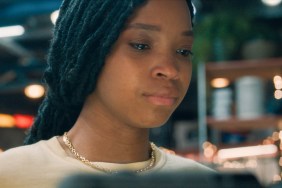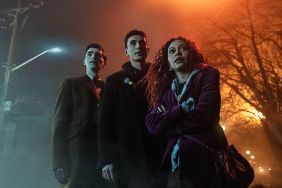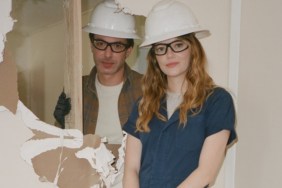On Friday, July 15, the ten-year film journey of the boy wizard known as Harry Potter will come to an end with Harry Potter and the Deathly Hallows Part 2. As much as the final movie has lots of great curtain calls and moments for all the characters we’re grown to know and love, more than anything, the movie is quite a crowning achievement for director David Yates, who came on board for the fifth movie Harry Potter and the Order of the Phoenix roughly seven years ago and just kept going, through the sixth movie, then finally tackling the impossible feat of shooting the two-part finale mostly at the same time. He has literally been working nearly non-stop since then, but if you read our review, you’ll know that we think he really outdid himself this time.
Considering that Yates has directed three of the biggest movies of the last decade (and the new one is likely to be a fourth), he is surprisingly humble and unpretentious which is why ComingSoon.net was very happy to sit down with the soft-spoken filmmaker once again for what might be our last interview with him in regards to “Harry Potter” at least until the 10th Anniversary Blu-ray Collection.
ComingSoon.net: So congratulations on finishing this. You look good. You look like you’re well rested.
David Yates: Thank you.
CS: Last time I talked to you here was for “Half-Blood Prince,” and if I remember correctly, the last book was released right as you finished your first movie, so did that change how you approached the other movies?
Yates: I only knew I was going to finish it really just not long before we met last time actually, so I was kind of finishing “Half-Blood Prince” and the whole notion of finishing the series. You may even have asked me–I’m sure I was committed at that point. I think I was–so I didn’t really have an opportunity to kinda construct a grand overview in those first two movies, because I only knew I was in for the whole ride halfway through “Half-Blood Prince.”
CS: When the novel of “Deathly Hallows” came out, did you read that right away?
Yates: Oh, yeah, totally. We all got a copy literally I think a day before it was on the shelves, so we had 24 hours before everybody else, and yeah, went right through it and made sure we hadn’t messed anything up. But Jo Rowling reads the scripts before we shoot anything and she’d already been working on “Hallows,” so she kinda knew I think that we were kind of on course and she would have flagged anything that was a bit out of kilter. After having read “Half-Blood Prince,” she would’ve said–even before we’d shot it–“You shouldn’t do that because you know what? When the book comes out in six months, I’m doing this.” She knew a lot more of what we were doing than we knew about what she was doing. (Laughs) Yeah, but she was cool with it all.
CS: Adapting any book is tough, but adapting these books must be really hard. This one you actually had to do two movies shooting at the same time. Did Steve Kloves actually have a full script for both parts before you started shooting any of it? How did that actually work as far as scheduling it?
Yates: I can’t quite recall, but we had a pretty robust script for “Part 1” and a working script for “Part 2,” and the script for “Part 2” evolved somewhat during the months of shooting. So we sort of tuned it a little as we went. “Hallows: Part 1,” we wanted it to be like a European road movie, very quiet, very intimate, and then “Hallows: Part 2” is a big spectacle, epic send-off as it were. Those two don’t sit that comfortably together.
CS: You have always said they were going to be different but I was surprised by how different the two halves of the movie are.
Yates: I wanted them to feel like different movies, not “here’s end of Part 1 and now let’s…”I wanted the first one to feel intimate, melancholic, poignant with this feeling of leaving home, leaving a place of safety. Suddenly these young kids and characters are feeling very vulnerable. Part 2, that was my opportunity to do a big opera with dragons and giants and spiders and stuff. Those books in the middle didn’t really give me that opportunity. “The Order of the Phoenix” was quite fat and complicated and “The Half-Blood Prince” was kind of developing a piece of the overarching story, so they were both transitional movies in a sense. So “Hallows – Part 2” is my first shot at doing a film that has an end, you know? (Laughs) That’s why I wanted to do it, I wanted to stay, so I could have a movie with an end rather than a movie with a comma.

CS: Because of it’s nature, this is also very effects heavy with so much CG. Were you able to shoot some of the stuff that needed CG earlier in the schedule so you’d have more time do those effects?
Yates: No, we do effects all the way as we’re shooting, effects coming in all the time, so we probably don’t have a very cost-effective way of doing visual effects on Potter. I’ll edit a scene very early on after I’ve shot it. Two weeks later, I’ll turn it over to the visual effects guys. They can do their initially blocking. It comes back to us. Then we’ll retune things, change it. The guys in the effects houses are working way through the shoot so when we get to post-production I’ve already seen and approved a number of things so then I can change and I do change. We have a huge amount of wastage on all the films. Certainly I have made and I suspect Alfonso (Cuaron) and Mike (Newell) had the same, because we all had the same sort of basic structure of working when it comes to sort of approving and defining effects. Lots of things get changed constantly and it’s only because Potter is successful and we have such a big budget that we can. I can imagine a visual effects movie that’s a bit leaner where you have to kinda commit early on and say, “That’s it.” We were never forced into that position. We always had a lot of latitude to change things as we went.
CS: I feel like the two directors who came before you, because they only did one movie each, they could focus on that and didn’t have to think ahead about what would happen after their movie. Did that make it easier or harder knowing that while you were finishing up the first half, you still had some big things to do in Part 2?
Yates: Yeah, it was constant. What was hardest I think was you were literally finishing one movie. As you were finishing one movie you were going straight into the next, so the bridges were always overlapping slightly and you were always doing about six million things at once. That’s just tough, mentally, physically it’s tough, but it was exhilarating. It was really exciting.
CS: What was your work day like? Was it literally 22-hour days with 15 hours on set and 7 hours editing and doing post?
Yates: Actually, no, it wasn’t crazy. We had sensible shooting hours, so we would start at eight in the morning, finish at five or six, but then I might spend some time with my editor or then I might prep the next day. So they were probably 12-hour days, which is not horrendous because I never shot in America, but from what I understand in America, you guys shoot crazy hours like 16-hour days or something.
CS: What’s interesting is that because you’re working with kids, as they got older, you could do longer days with them, because I imagine for the first few movies, they could only do eight hour days.
Yates: Yeah, we did, we actually had only four hours on camera with them when we started, which is crazy. So you’re like, “What do we do with the rest of the day?” We’d turn around and shoot some grownups then, but no, it was challenging.
CS: I really liked that you were able to bring the two actors you worked with on “Girl in the Café”–Bill Nighy and Kelly Macdonald–into the Potter world, but they’re both absolutely perfect in the roles you cast them, especially Kelly in this last one.
Yates: She’s a great actor, Kelly. She didn’t really have that much to do, but she didn’t have very long in that scene. It’s what, two minutes or three minutes long? But she has a wonderful presence and she makes a great impression. I adore both of them as actors and I’m always looking for things to do with them, Bill especially because I think Bill’s great too.
CS: I’d imagine making this movie must’ve been very emotional for a lot of people, because many of them have their big last scenes, saying “goodbye,” and destroying lots of the sets that have been around from the beginning including the Quidditch Arena. Were there any scenes you waited until the very end to shoot?
Yates: Actually, two scenes perfectly parked themselves towards the end of the schedule. One was the scene on the viaduct as the three of them are saying goodbye to the school. Where Emma bows her head and they hold hands and the camera pulls away. On that day, I said to them that “this is you saying ‘goodbye.'” It was the last big scene they were all doing together on the same day at the same time, so it was a way of saying goodbye to everything. The King’s Cross scene at the end that was the epilogue, I shot a version of it halfway through our schedule, but it didn’t work, the makeup. It didn’t look right. I was having to shout direction at these little kids, and it’s hard to get performances out when you shout at people, so I reshot it, but we pushed it right at the end of the schedule. I think moving it right to the end was really useful because most of the film had been behind us, so it made sense that that was now at the end somehow.

CS: I wanted to ask about working with composer Alexandre Desplat because he’s just an amazing musician and he did great work in the last movie but I felt he outdid himself this time around. I was curious how you worked with him, because he really was able to capture every emotion and up it.
Yates: Yeah, for sure, for sure.
CS: Does he get a lot of the scenes very early on?
Yates: He came in and for “Hallows – Part 2” and I just showed him a cut that was three or four weeks away from finishing, so it was quite early for me, but it was essential that he got his feet under the desk and started work. What I love about his music is it’s muscular but emotional, for this particular movie at least. The last movie had to be quite haunting and poignant and quite small really, but for this we needed a great wide score with real depth and color and dynamic. I would just go around to his house in Maida Vaile in London. We got a house in Maida Vale, and I’d go around and we’d watch scenes and we’d talk about the scenes. I’d go away, he’d write something, I’d come back, he’d play it, I’d give notes and he’d work on the notes. I’d come back and we’d end up in a really lovely place. Then we had London Symphony Orchestra who were great. It’s like the Rolls Royce of orchestras; they can play anything and they get it really quickly.
CS: How many days did you have with them?
Yates: We had about two-and-a-half weeks. We were really, really spoiled, so we were able to noodle and change things. Alexandre was brilliant because he’s been nominated for Oscars many times, but he was really sweet. I said to him, “Alexandre, do you mind if we have some recording days, but once we’ve recorded everything, throw it onto the movie and have a gap and come back and look at the movie and see if we want to change any of the score?” He was totally up for that and we changed a couple of things. I sat with him between those sessions and we watched the movie with this score we’d recorded. We both knew immediately, “Well, let’s change that and change that.” He would go away and we’d revise. Because with a script, when you do a script, you do 20 versions of a script.
CS: If you only do 20 versions on a script that’s not a lot.
Yates: Yeah, I know, but actually, with Steve Kloves you don’t have to do 20 versions, you end up doing half a dozen because he’s good, and with a performance you do anywhere between three takes and 20 takes, so it seems crazy to me to just do the score and then step back and go, “That’s it guys.” So we got a chance to revise a couple of things.
CS: You mentioned the O-word, “Oscars.” The last movie in “The Lord of the Rings” trilogy basically swept the Oscars. With these movies, they have many fans but there’s never really been time to campaign or do the whole awards media circus, because you’re busy making the next movie. Do you think you’ll be out there really pushing to try to get some acknowledgement from the industry for the series now?
Yates: You know, I’m not sure. I would love to think some of that might come, but we’ve made peace with that whole thing ages ago. It’s sort of not something that we necessarily chase. It would be a marvelous thing if after ten years, David Heyman was recognized. If it comes and would we get involved with campaigning? If the studio or if David said to me, “Come on, let’s really go for it.” But it feels to me that we’ve made the films that are out there and are universally generally popular. I think that’s a beautiful thing and I’m sort of satisfied with that. I hope the Academy will recognize Stuart Craig, (cinematographer) Eduardo Serra, as well as the visual effects guys. I think that would be a wonderful thing. It’s been an odd journey because it started as a kid’s movie. Brilliantly, Chris Columbus cast it perfectly and made it incredibly accessible, and it’s gone through this odd morph, and I think “What is it? Where is it going? But I hope some of the people who have worked on it get acknowledged, I do.
CS: Well, I have to say that the movie I saw last night was as good as “The King’s Speech.”
Yates: Oh cool. Awww… that’s fantastic.
CS: And you come from the same background as Tom Hooper as well.
Yates: Yeah, that’s true. We both came through (that).
CS: I’m sure a lot of people today are going to be asking you what you’re going to do next other than taking some time off an resting? Many of our readers have mentioned your name as someone they’d like to see direct the next “Thor” movie or even “Transformers.” Do you want to do another franchise or do you need to do something small now?
Yates: I need to do something really small, really lean. I need too step away from Potter, and I’ve got some really terrific options actually – I’ve just got to decide which one is the right one. I’ll have six months off to chill out and relax. I need six months just to get my head back really, then next year I’m going to make quite a small movie, just something that’s as far away from visual effects and genre pictures as possible. Then I’ll be gearing up a big, big project for the year after that. Yeah, so I love doing these big movies, it’s like a big train set.

CS: It’s gotta be addictive.
Yates: It is totally addictive, it’s true, yes. (chuckles)
CS: I can’t imagine after doing something like this, you can go back to directing two people in a room.
Yates: I know, but going back to two people in a room movies are actually good as a palate cleanser. The problem with these big movies, certainly the ones I’ve been making recently, is you have everything and you’re indulged. I think what that does to you, if you tap into that too often too much, I think you start to… if you look at some directors who’ve been commercially successful, creatively they can just start to do that because no one says “no.” Every problem you solve by just writing another check and you’re never using this. (points to his head) So I need to just do something lean and mean where it’s a really short shoot and we’re challenged, everyone who works with me is challenged to kind of think really laterally. Then I’ll go back and do something humongous.
And here’s a few more tidbits from Yates from the press conference that followed…
Q: What was the most challenging scene to shoot?
Yates: The most challenging scene was Gringott’s bank vault. It doesn’t look very complicated but when those three characters go into that small room and that treasure starts to replicate, we had to design a hydraulic floor which would lift all the treasure up. We figured out ways of putting cameras in there and it was a completely enclosed set. It took months and months of planning even though it runs for two-and-a-half minutes.
Q: How did you approach the 3D conversion?
Yates: I’m not a huge fan of 3D. I was very nervous about, it but I decided that there was a every elegant and beautiful way of doing 3D which would help the experience of enjoying the film. Basically, we just took a much deeper approach, very little comes out the front of the screen which I find distracting and disturbing. I used 3D like music. In quiet intimate scenes, it’s very shallow, and in big, more dynamic scenes, it’s very deep, and my brief to the people we were working with always, “It’s got to help story, it’s got to tell story.” We spent a lot of money and took a lot of time with the 3D and I would see shots that would go back and get changed all the time. Every single shot in the movie had a lot of attention and a lot of care devoted to it to make sure the 3D experience enhanced the story and made watching Harry Potter more enjoyable, not less.
Q: Is there any interest in converting the rest of the series into 3D?
Yates: It’s just the time that it takes, because we spent so much time converting this one. One would have to put other projects on hold while you went back and did it. It’s not something that you turn over to someone to do it. You judge every single shot. It’s like you directing a movie still. It’s an enormously important process so I’d have to set months aside to do it, and I might just be wanting to be away doing other things. There may be pressure to do it at some point. Maybe it will be good to do it further, further, further down the line possibly. But just now, I’d leave them as they are, it’s probably better.
Q: Were there any extra scenes that were cut for time that might end up on the DVD?
Yates: Yeah, we’ve got a whole bunch of DVD extra scenes, which I took out of the movie. We never ever say, “Oh, it’s going to be 3 hours or 2 1⁄2 hours or 90 minutes.” It’s whatever feels right when you watch the film in the dark. Ultimately that’s what determines the length of the film. This film felt the right weight and the right shape and the right rhythm at two hours, but we saved all the bits we cut out, and we’re going to put that on the DVD extras.
Q: Can you tell us what that might include?
Yates: Yeah, there’s a version of Aberforth and Harry, a longer version of it that we’ve got. There’s an extended scene on the beach with Ron disguised before he gets to the bank and a lovely interchange between him and (Hermione).
Q: Can you talk about staging the final battle scene between Harry and Voldemort? (potential minor spoiler in the following response)
Yates: In the book, they circle each other in the Great Hall in front of lots of students and I wanted to extend it across the school. It was a great visual opportunity to see those two figures fighting amongst the rubble through different parts of the school. I was sitting in my garden in Warwickshire trying to think of a way of giving it a bit of extra meaning ’cause two guys fighting all the time kind of gets exhausting after a while. I just came up with this notion of Harry looking at Voldemort when they’re on a precipice and pulling him over, and that was my eureka moment in the garden one Sunday as I was having a cup of tea. I thought that could be really beautiful with these two figures just tumbling into the abyss and then conjoining in this weird way would be haunting and very expressive. Thinking about things that are on the DVD extras. There was more battle between the two of them. There’s a moment you probably saw in early trailers where Voldemort is looking at Harry and he says, “Why do you live?” and Harry says, “Because I have something to live for.” It was a really cool moment and I actually asked Steve (Kloves) to write it. I said, “Steve, we’ve waited eight movies, I want Voldemort to say something!” and of course when I put it in the movie–and the reason Steve didn’t write it in the first place-is because Voldemort would just kill Harry. They wouldn’t stop and have a conversation. It was in the movie and I had a slightly longer sequence of them fighting. You pull it out in a trailer and it looks quite cool, but in context, it feels slightly labored and a little self-conscious, so we kind of lost it.
Harry Potter and the Deathly Hallows Part 2 opens in 3D, 2D and IMAX 3D theaters on July 15.
